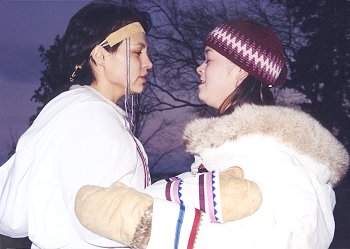"It goes like this. Two women face each other very closely, and they throat sing like this. If I would be with my partner right now, I would say A, she would say A, I would say A, she would say A, I say C, she says C. So she repeats after me. It would be a sort of rolling of sounds. And, once that happens, you create a rhythm. And the only way the rhythm would be broken is when one of the two women starts laughing or if one of them stops because she is tired. It's a kind of game. We always say the first person to laugh or the first person to stop is the one to lose. It's nothing serious. Throat singing is a way of having fun. That's the general idea, it's to have fun during gatherings. It is also a way to prove to your friends around you or your family that if you are a good throat-singer, you're gonna win the game."
 |
| Source: mustrad.org.uk |
Traditionally, katajjaq was intended to be more along the lines of a form of entertainment, rather than music. It was considered to be a type of vocal/breathing game among Inuit women, who were the main participants. They would engage in katajjaq while men were away on hunting trips, and it gave them great entertainment in order to pass the time.
Although Inuit life has changed significantly over the past century, many traditions continue. Inuit Qaujimajatuqangit, or traditional knowledge, remains an extremely important parts of their culture. Examples of this traditional knowledge are mythology, music, dancing, and storytelling. As has always been the case, family and community are very important to the Inuit. Many dialects of the Inuit language are still widely spoken and used in mass media, like television and radio. Also, most signage is printed in both English and Inuktitut (one of the main Inuit languages of Canada).
Interview source: http://www.mustrad.org.uk/articles/inuit.htm
No comments:
Post a Comment